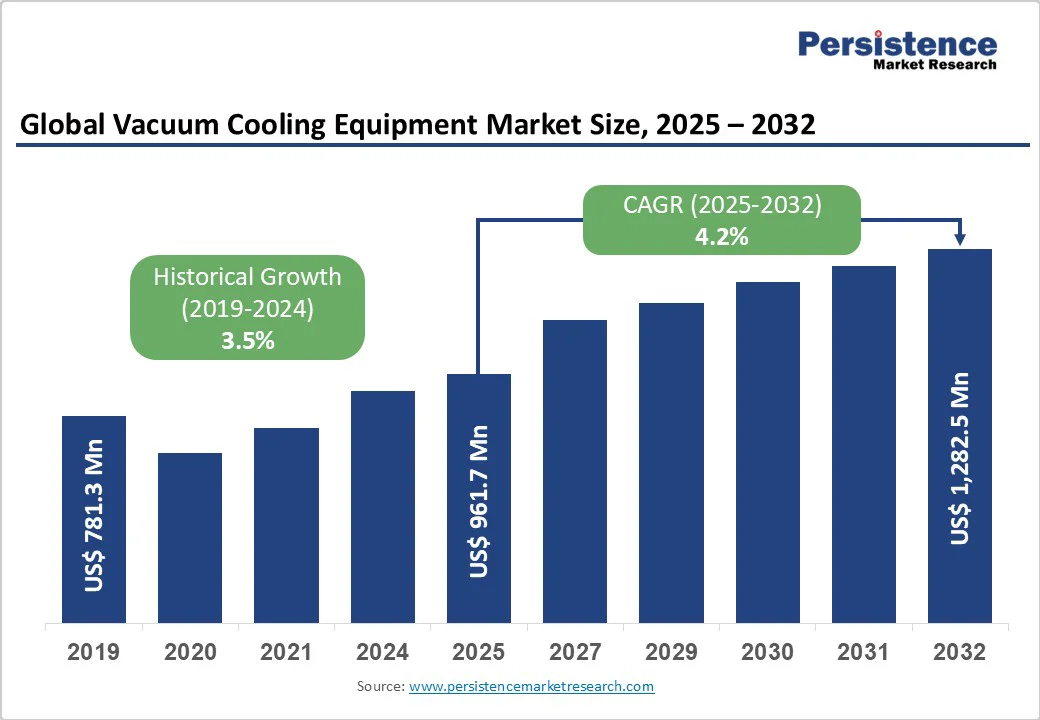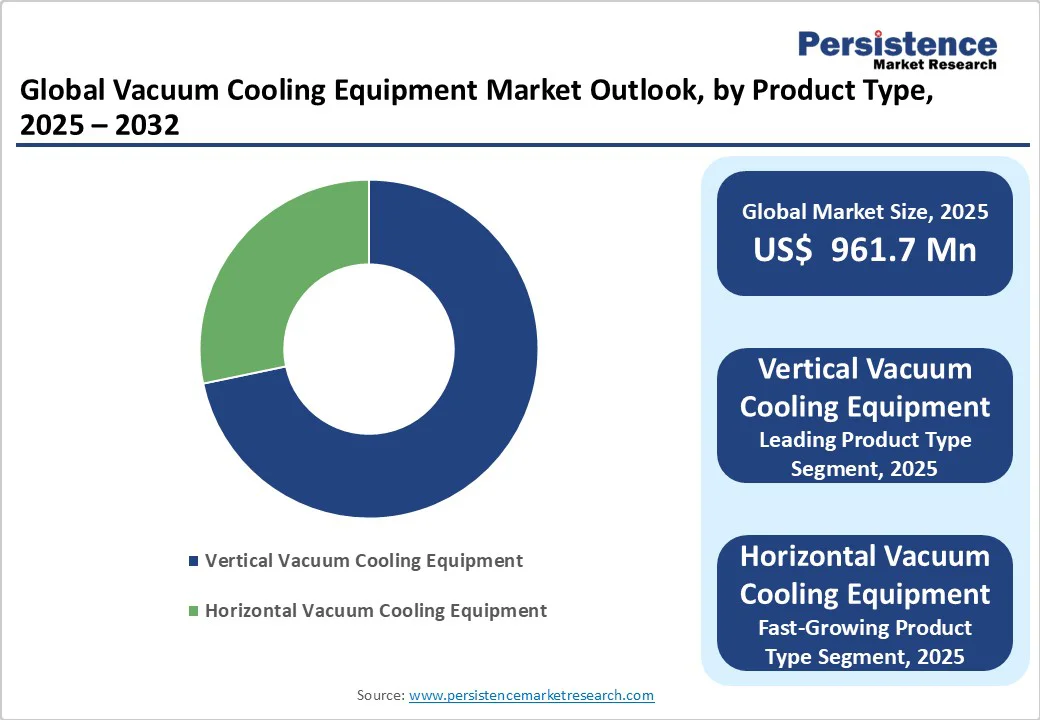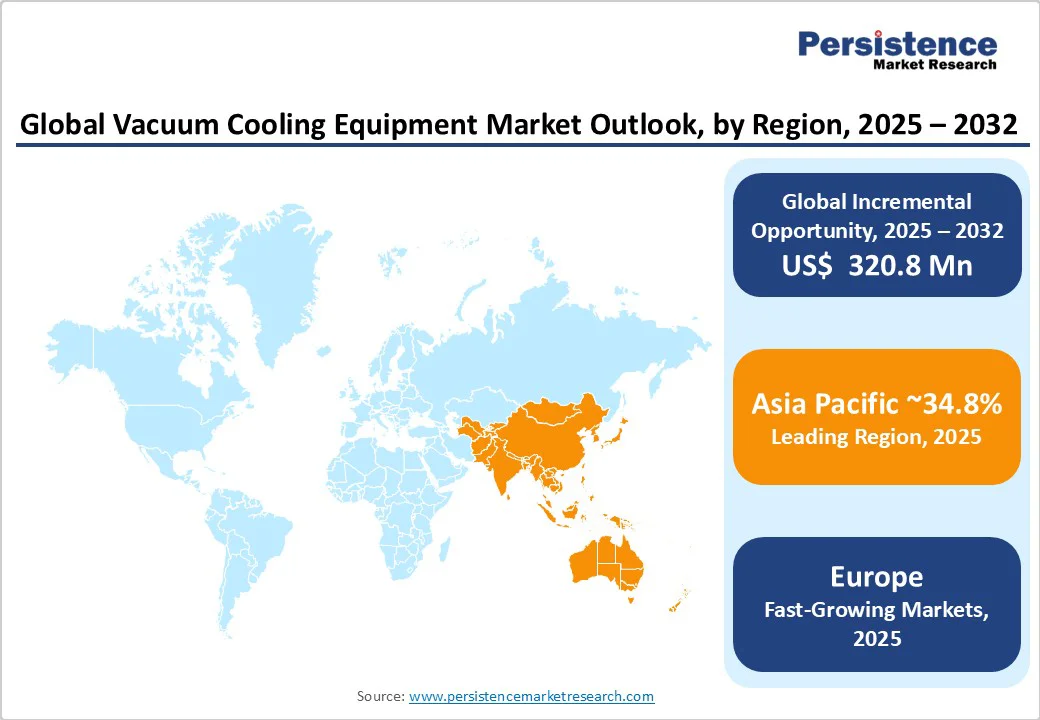ID: PMRREP35752| 197 Pages | 17 Oct 2025 | Format: PDF, Excel, PPT* | Industrial Automation

The global vacuum cooling equipment market size is expected to reach US$961.7 million by 2025. It is projected to reach US$1,282.5 million by 2032, growing at a CAGR of 4.2% during the forecast period 2025 - 2032, on account of the increasing demand for advanced cooling solutions across food processing, bakery, and agricultural sectors, driven by stringent food safety regulations and the growing emphasis on extending product shelf life while maintaining quality.
| Key Attribute | Details |
|---|---|
| Vacuum Cooling Equipment Market Size (2025E) | US$961.7 Mn |
| Market Value Forecast (2032F) | US$ 1,282.5Mn |
| Projected Growth (CAGR 2025 to 2032) | 4.2% |
| Historical Market Growth (CAGR 2019 to 2024) | 3.5% |

The development of energy-efficient vacuum cooling systems has emerged as a significant market catalyst, with modern systems consuming up to 40% less energy than traditional cooling methods. Recent innovations include the integration of screw vacuum pumps, autonomous capabilities, and IoT-enabled monitoring systems that optimize cooling parameters in real-time.
Leading manufacturers have introduced variable speed drive (VSD) technology, which adjusts pump operation to match current demand, thereby substantially reducing energy costs. The advancement of materials technology, particularly corrosion-resistant alloys and modular aluminum designs, has enhanced system durability while reducing weight and maintenance requirements.
These technological improvements have made vacuum cooling more accessible to medium-scale food producers while providing substantial operational cost savings.
Aiding this is the growth of international food trade and complex supply chains that have created substantial demand for efficient cooling solutions that maintain product quality during extended transportation periods. The Asia Pacific's agricultural sector is growing at a rate of 5.2% annually, driving increased adoption of advanced preservation techniques.
The expansion of e-commerce grocery platforms and micro-fulfillment centers has further amplified demand for compact, high-performance cooling systems that ensure temperature consistency throughout the distribution network.
The substantial upfront expenditure for vacuum cooling systems, ranging from US$200,000 to over US$1 million per unit, poses a significant barrier to adoption for small and medium-sized enterprises, particularly in emerging markets.
Annual maintenance expenses, including bi-annual oil and filter replacements, annual exhaust filter changes, and full overhauls every 5-10 years, add 15-25% to operational budgets, further deterring cost-sensitive users. The need for specialized installation, facility upgrades, and trained technicians elevates the total cost of ownership, constraining market growth among smaller food processors and growers.
Moreover, vacuum cooling delivers optimal performance only for high surface-area-to-volume products, limiting its applicability for dense or waxy produce such as carrots, potatoes, and tomatoes, which exhibit poor moisture evaporation and risk 3-5% weight loss under suboptimal conditions.
Precise control systems and experienced operators are necessary to prevent overcooling, product dryness, and quality degradation. Sophisticated filtration, which manages debris and organic contaminants, increases system complexity and downtime.
The increasing integration of automation and IoT-enabled technologies within vacuum cooling systems presents significant market expansion opportunities. Smart vacuum systems can instantly monitor and optimize pump performance through integrated sensors, reducing operational interruptions and maintenance requirements.
The development of AI-enabled control systems that analyze product type and ambient conditions to optimize cooling times represents a substantial technological advancement. These smart solutions combine vacuum cooling with other preservation methods, creating comprehensive food safety platforms that meet evolving industry demands while providing significant competitive advantages.
Environmental sustainability and food waste reduction have created substantial opportunities for the adoption of vacuum cooling technology. Vacuum cooling helps reduce waste, increase yield, and transform waste into value through improved preservation capabilities.
The technology's ability to extend shelf life by up to 50% while reducing energy consumption aligns with corporate sustainability goals and regulatory requirements. The expansion of international trade in perishable goods, where temperature management is crucial, continues to drive demand for advanced vacuum cooling solutions across global supply chains.
Vertical vacuum cooling equipment is expected to dominate the global market, accounting for a commanding 55% revenue share in 2025, driven by its space-saving configuration and efficient cooling performance. Featuring a vertically stacked design integrating the motor, steam condensation unit, and collection container, these systems minimize floor space requirements while maintaining high operational efficiency.
Their compact structure makes them ideal for space-constrained environments, providing effective steam suction, simplified condensate drainage, and ease of installation. As industries such as food processing, horticulture, and pharmaceuticals increasingly prioritize productivity within limited floor areas, vertical systems have emerged as the preferred choice due to their maneuverability and reliability.
In contrast, horizontal vacuum cooling equipment represents the fastest-growing segment, favored for its robust performance in heavy-duty applications and extended handling capacity. Its elongated layout accommodates larger material volumes and offers enhanced accessibility for maintenance and servicing.
With advantages such as lower height requirements, high throughput, and versatile temperature control, horizontal configurations are gaining traction in large-scale industrial facilities that seek durable, high-capacity cooling solutions.
Air-cooled screw vacuum pumps are poised to lead the cooling type segment with a commanding 63.5% market share in 2025, primarily due to their energy efficiency and reduced operational complexity. Air-cooled systems utilize ambient air rather than water to remove heat loads from vacuum pumps, eliminating the need for external water cooling infrastructure.
These systems offer superior cooling efficiency in most industrial environments, with recent innovations including integrated radiators and dual electric fans that enhance performance while reducing maintenance requirements. The air-cooled design offers several advantages, including lower installation costs, reduced risk of water-related contamination, and simplified maintenance procedures, which appeal to food processing facilities that prioritize hygiene standards.
Water-cooled screw vacuum pumps are expected to be the fastest-growing segment within the cooling type category, driven by their superior performance in high-capacity applications and extreme operating conditions. Water-cooled systems use liquid coolant from external units to achieve more effective temperature control, particularly beneficial for high-pressure applications and environments with elevated ambient temperatures.
These pumps offer enhanced energy efficiency in maintaining optimal operating temperatures, resulting in lower energy costs over extended operating periods. The growing adoption is attributed to their ability to handle larger cooling loads while providing consistent performance in demanding industrial environments.
Bakery products are expected to dominate the vacuum cooling equipment market, accounting for 42.7% of the total share in 2025, highlighting the essential role of rapid cooling in commercial baking. Vacuum cooling technology has revolutionized bakery operations by significantly reducing cooling times from hours to minutes, resulting in a 30-50% increase in production capacity.
It is particularly effective for bread, pastries, rolls, and other baked goods, preserving texture, preventing sogginess, and extending shelf life. Modern bakeries are increasingly utilizing this technology to transition from night to day shifts, thereby reducing labor costs, improving working conditions, and addressing workforce shortages. Furthermore, vacuum cooling enables reduced baking times while maintaining product integrity, such as producing juicier, more stable brioche rolls.
Meanwhile, fruits and vegetables represent the fastest-growing application segment, driven by the rising global demand for fresh produce and export expansion. Vacuum cooling rapidly reduces temperature within 20-30 minutes, compared to 10-12 hours in traditional cold storage, preserving moisture and freshness. Advanced hydro-vacuum systems further minimize weight loss, supporting export-oriented agriculture in regions like Brazil and other key producers.

Asia Pacific is predicted to dominate the vacuum cooling equipment market, holding a 34.8% share in 2025, primarily driven by its strong agricultural output and rapidly expanding food processing sector. The region’s leadership is driven by rising consumer demand for fresh produce, healthy bakery products, and extended shelf-life solutions.
China, Japan, India, and ASEAN countries are experiencing robust growth due to manufacturing efficiencies, export-oriented horticulture industries, and substantial government investments in agri-tech and cold chain infrastructure.
According to recent estimates, the region’s agricultural sector is projected to grow at a rate of 5.2% annually, supported by subsidies, infrastructure development, and awareness programs that promote modern cooling technologies among small and medium-sized producers. The emergence of modular and mobile vacuum cooling units has further improved accessibility for both large-scale and small agricultural enterprises.
Additionally, lower production costs, established supply chains, and proximity to component suppliers enhance cost competitiveness. The increasing emphasis on food safety standards and ongoing modernization of the cold chain continue to attract significant investments in vacuum cooling technologies across the Asia Pacific.
Europe is the fastest-growing regional market for vacuum cooling equipment, fueled by stringent regulatory standards, advanced industrial capabilities, and a strong focus on sustainability. The market is projected to grow at a CAGR of 4.6% through 2032, supported by well-established floriculture and horticulture sectors in the Netherlands, Germany, and the U.K., which have been early adopters of vacuum cooling systems.
EU food safety regulations requiring rapid cooling to prevent microbial contamination act as a major growth driver, while government incentives promoting energy-efficient industrial equipment align with EU Green Deal objectives.
The region’s commitment to sustainable manufacturing encourages innovations in low-GWP refrigerant systems and energy-efficient designs. The integration of AI and IoT technologies enables predictive maintenance and real-time monitoring, thereby enhancing operational efficiency in European food processing facilities.
Growing consumer demand for organic and minimally processed foods further supports the adoption of vacuum cooling, as it preserves freshness, nutritional quality, and shelf life. Europe’s mature industrial base, skilled workforce, and regulatory leadership make it a global hub for advanced vacuum cooling technologies across food, pharmaceutical, and industrial sectors.

The global vacuum cooling equipment market structure is moderately consolidated, with multinational corporations and specialized regional players holding estimated market shares of 5-15%, while numerous smaller manufacturers serve niche segments.
Manufacturers are focusing on technological innovation, energy-efficient solutions, and global distribution networks to maintain competitive advantages. Key differentiators include IoT-enabled automation, predictive maintenance, modular design, and customized solutions for industries such as food processing, pharmaceuticals, and chemicals.
Recent developments indicate that manufacturers are emphasizing product innovation and market expansion. Between 2024 and 2025, Busch launched the COBRA NC 2500 C vacuum pump with integrated cooling, while Dekker Vacuum Technologies introduced custom-engineered systems for the fresh produce industry.
Atlas Copco’s acquisition of Delta Temp strengthened its European presence and specialty cooling capabilities. Leading manufacturers are increasingly integrating smart sensors and AI-enabled controls to optimize cooling processes, reduce downtime, and improve operational efficiency.
The global vacuum cooling equipment market is projected to reach US$ 961.7 million in 2025.
The increasing demand for advanced cooling solutions across food processing, bakery, and agricultural sectors, driven by stringent food safety regulations, and the growing emphasis on extending product shelf life while maintaining quality are driving the market.
The vacuum cooling equipment market is poised to witness a CAGR of 4.2% from 2025 to 2032.
Rising consumer preference for fresh, minimally processed foods, the integration of IoT-enabled controls and automated systems, and advancements in materials technology and smart vacuum pumps are key market opportunities.
BVT, Archer Daniels Midland Company, and Ashland are mentioned in the report.
| Report Attribute | Details |
|---|---|
| Historical Data/Actuals | 2019 - 2024 |
| Forecast Period | 2025 - 2032 |
| Market Analysis Units | Value: US$ Mn, Volume: Units |
| Geographical Coverage |
|
| Segmental Coverage |
|
| Competitive Analysis |
|
| Report Highlights |
|
By Product Type
By Cooling Type
By Application
By Region
Delivery Timelines
For more information on this report and its delivery timelines please get in touch with our sales team.
About Author